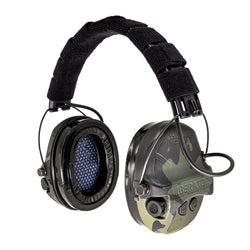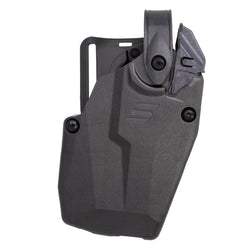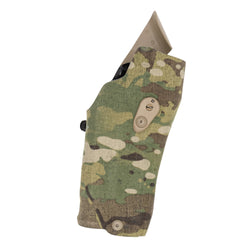Americans love the AR-15 rifle, and today, 5.56 is not the only popular caliber for it. .300 AAC Blackout is now a common caliber associated with the AR-15, and much of this can be credited to one specific accessory: the silencer, or suppressor.
Over the years, firearms and cartridges rise and fall in popularity. Some calibers manage to stay afloat and remain what I would call “common” handgun or rifle calibers. These would include 9mm, .45 ACP, 5.56 NATO, and .308 Winchester.
While the popularity of those cartridges may fluctuate, they have not seen the same decline as other calibers in the past. But even when a caliber appears to have lost its popularity in the civilian market, it doesn’t mean it’s gone for good. I remember when .300 Blackout was released. It got some attention, but wasn’t really a smash hit.
I mean, why buy an oddball caliber rifle when you could use the popular 5.56 NATO round? It’s easy to find and much cheaper than .300 Blackout. Yet, people are turning to .300 blackout, and the rise in popularity of silencers is what’s fueling it.
History and Safety Precautions
The .300 AAC Blackout, often shortened to just .300 Blackout or .300 BLK, was created around 2010 with a purpose. Advanced Armament Corporation (AAC) developed it to meet a specific military need. The goal was to provide a round for the AR-15 platform that had greater terminal ballistics than 5.56 NATO. It also needed to work reliably in short-barreled rifles (SBRs) and when suppressed.
Early on, .300 Blackout started to get a bad reputation because it was more expensive than 5.56 and there were safety concerns. As you know, someone can mistakenly chamber a .300 Blackout in a rifle meant for 5.56 or .223. The length of the cartridge is about the same, and the only part that is different on a .300 Blackout AR-15 rifle is the barrel.
Over time, people have started taking some safety precautions like installing dust covers that clearly state “.300 Blackout” and/or putting ranger bands marked .300 Blackout around the magazines. While you can easily tell the difference in cartridges by looking at them, mixing up your magazines is easier than you think.

SBR Efficiency: Why .300 BLK Shines in Short Barrels
As I mentioned above, one of the goals for .300 Blackout was for it to be reliable and efficient in SBRs. To achieve this, they designed the .300 Blackout to use fast-burning powder. This powder can completely burn in a much shorter barrel.
For example, a 5.56 round in a 10-inch barrel loses significant velocity. This is due to a good portion of the powder not fully combusting.
The .300 Blackout, by contrast, is highly efficient in barrels as short as 9 to 10.5 inches. This efficiency allows for maximum velocity potential in a short barrel, which, of course, makes it ideal for close-quarters scenarios.
The Silent Advantage: Subsonic Ammo & Suppression
The primary reason for the .300 Blackout’s current resurgence is its exceptional performance with silencers. This is directly tied to its ability to shoot both supersonic and subsonic ammunition.
Subsonic ammunition is key to a “quiet” firearm. A round is subsonic if its speed is less than the speed of sound (approximately 1,125 feet per second). Standard rifle rounds are supersonic. When they exit the muzzle, they create a small sonic boom. This “crack” is loud and can cause damage to your hearing if hearing protection is not used.
Adding a silencer will reduce this sound. And when you use a sub-sonic round and a silencer, you get the maximum sound reduction.
When you reduce the speed of a bullet (to subsonic speeds), you greatly reduce decibels. Because the .300 Blackout is a heavy bullet, it retains enough energy for effective use at slower speeds. The large diameter (.30 caliber) and heavy weight provide a good balance of quietness and down-range “punch, “which is one reason they are perfect for close quarters. The caliber and silencer complement each other.

There is no question that silencers are becoming more popular in the civilian market. They are not only safer for your hearing, but they also improve the firearms’ recoil, velocity, and accuracy. The recent change in the NFA tax stamp fee (from $200 to $0) will no doubt increase the popularity of silencers even more. This, in turn, will only boost the popularity of the .300 AAC Blackout cartridge.
The Science: How a Suppressor Reduces Sound
We won’t get too deep into the science behind how a silencer is made and how it works. But I do want to cover the basics for those who may not be as familiar with them.
A silencer is really a simple, yet ingenious, device. Technology and innovation from the country’s leading manufacturers have also taken this simple design to an all-new level.
At the heart of it, a silencer works by trapping and cooling the hot, high-pressure gases as they follow the bullet out of the barrel. It’s the rapid expansion of these gases into the atmosphere that causes the loud muzzle blast.
The silencer attaches to the muzzle and contains a series of baffles and expansion chambers. As the gases enter, they are forced into the chambers. Here, the gases expand, slow down, and cool off. This process reduces their pressure significantly. By the time the gases exit the end of the silencer, their pressure is much lower. This results in a vastly quieter sound signature.

Featured Suppressor Review: SilencerCo VELOS LBP 762
When selecting a silencer for a .300 Blackout rifle, the VELOS LBP 762 is among my favorites because of how well it works and because it’s so durable.
It is made of 17-4 stainless steel and a 3D printed Inconel 625 core that is fully welded. When compared to other silencers, it’s hard to find a silencer that will hold up to constant use like this one.
This is partly because of the patented Hoplon blast baffle SilencerCo makes. This type of baffle deflects debris, which extends the life of the silencer when it’s used on short-barrel rifles (like a .300 Blackout). It also has a V-Series Cerakote finish, which is extremely durable and helps to protect the exterior of the silencer.
My Velos LBP 762 came with an ASR muzzle device, which I love. You can purchase extra ASR muzzle devices (which are also flash hiders) to attach to other rifles. This makes it super easy to use the silencer on multiple firearms while maintaining a flash hider on each one.
The flash-hider has threads around the outside of it, and the silencer simply fits over the flash-hider and screws onto it. After screwing the silencer onto the short threads, turn the quick lock ring, and the silencer locks in place. Without a system like this, you would need to screw the silencer directly onto the barrel. Of course, this means you would need to remove the standard muzzle break/flash hider that came with your rifle. But again, an ASR muzzle device comes with the silencer.

Real-World Application: Home Defense & Sound
The first rifle I used with my VELOS LBP 762 is an Aero Precision AR-15 pistol. It has a 10-inch barrel and sounds about like a .22 when shooting it. And to be clear, that’s when I’m using sub-sonic ammo. You can use higher velocity rounds, but the sound will increase.
For this review, AmmoToGo.com provided some .300 Blackout Winchester Super-Suppressed 200-grain ammo. It has a muzzle velocity of 1060 fps. With this ammo, recoil is light, and the buffer-spring in the gun is almost louder than the sound of the cartridge going off.
This setup is perfect for home defense because it has a heavy bullet and a lower muzzle velocity. That means you get great stopping power at closer distances, while reducing the risk of over-penetration. And when a silencer is attached, you don’t have to worry about damaging your hearing if an incident does occur.
Building the .300 BLK SBR: Accessory Breakdown
For those wanting some ideas on setting up their own .300 Blackout rifle, here are the accessories I have on mine. I chose these because they are affordable, yet extremely durable and user-friendly.
Cloud Defensive Handguard
This handguard has a section of the Picatinny rail that is lowered so a pressure switch can be used while keeping it somewhat level with the top of your rail.
Nightstick LGL 160-T
Nightstick has become one of my favorite light brands. They have a ton of options for both rifle and handgun lights, and of course, handheld lights as well. I’ve never had any problems with their lights and love the wire management systems they provide with them. The pressure switch on the LGL 160-T fits perfectly into the cutout area on the handguard.

Vortex AGM UH1 Gen II
For those who like holographic sights, Vortex’s AGM UH1 is an awesome sight system. It has a quick-attach system for Picatinny rails, so no tools are needed. You can also open the battery door without any tools, making it easy to swap out the CR123A battery when needed.
Another thing I like about this optic is the size and location of the control buttons. Three large buttons are located on the rear of the site that control the brightness and night vision settings.

SilencerCo Velos LBP 762
As I mentioned earlier in this article, the SilencerCo Velos LBP 762 is an extremely durable silencer. It does great at sound suppression in .300 blackout, 7.62×39, 5.56 NATO, .308, 6.5 Creedmoor, and other rifle calibers.
For anyone planning to use their silencer on a regular basis, this is one of the best heavy-duty options you will find.









